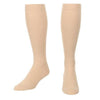Can Compression Socks Help with Edema?

Table Of Contents:
Edema is a condition that causes swelling in the body's tissues. It is most commonly seen in the legs and feet, but it can also affect the arms, face, and abdomen. Edema is caused by a buildup of fluid in the tissues. This can happen for a variety of reasons, including:
- Injury
- Surgery
- Pregnancy
- Varicose veins
- Lymphedema
- Heart disease
- Kidney disease
- Liver disease
- Medications
Edema can be mild or severe. In mild cases, it may cause only minor discomfort. In severe cases, it can make it difficult to walk or move. Edema can also lead to skin problems, such as itching and sores.
There are a number of treatments for edema. Some of the most common include:
- Elevating the affected area
- Applying ice
- Taking diuretics
- Wearing compression socks
Compression socks are a type of elastic hosiery that applies graduated pressure to the legs. This pressure helps to improve blood flow and reduce swelling. Compression socks are available over-the-counter or by prescription.
There is a growing body of evidence that suggests that compression socks can be an effective treatment for edema. A study published in the journal "The Lancet" found that compression socks were effective in reducing swelling and improving quality of life in people with chronic venous insufficiency. Another study, published in the journal "Phlebology," found that compression socks were effective in reducing swelling and pain in people with lymphedema.
How Compression Socks Work
Compression socks work by applying graduated pressure to the legs. This pressure helps to improve blood flow and reduce swelling. The pressure is highest at the ankle and decreases gradually towards the knee. This helps to push fluid out of the tissues and back into the bloodstream.
There are three main types of compression socks:
- Graduated compression socks: These socks apply the most pressure at the ankle and the least pressure at the knee.
- Inelastic compression socks: These socks do not apply graduated pressure. They apply the same amount of pressure throughout the leg.
- Elastic compression socks: These socks apply more pressure than inelastic compression socks, but not as much pressure as graduated compression socks.
The type of compression sock that is right for you will depend on the severity of your edema. If you have mild edema, inelastic compression socks may be enough. If you have moderate to severe edema, graduated compression socks may be necessary.
How to Wear Compression Socks
Compression socks should be worn on the leg that is affected by edema. They should be put on first thing in the morning before you get out of bed. If you have trouble putting on compression socks, you may need to ask someone for help.
To put on compression socks:
- Sit down in a comfortable chair.
- Place the heel of the sock over your toes.
- Slowly roll the sock up your leg.
- Make sure that the sock is snug but not too tight.
Compression socks should be worn all day long. You can take them off at night to sleep.
How to Care for Compression Socks
Compression socks should be hand-washed in cold water with a mild detergent. They should be air-dried on a flat surface. Do not put compression socks in the dryer.
Compression socks should be replaced every six months or sooner if they become damaged or worn.
Benefits of Compression Socks
Compression socks offer a number of benefits for people with edema. These benefits include:
- Reducing swelling
- Improving blood flow
- Reducing pain
- Improving quality of life
Compression socks can also help to prevent complications of edema, such as skin problems and ulcers.
Side Effects of Compression Socks
Compression socks are generally safe for most people. However, there are a few potential side effects, including:
- Skin irritation
- Pain
- Burning sensation
- Numbness
- Tingling
Conclusion
A pair of quality compression socks is an effective treatment for edema. They can help to reduce swelling, improve blood flow, and reduce pain. Compression socks are generally safe for most people, but there are a few potential side effects. If you are considering using compression socks to treat edema, it is important to talk to your doctor first.
1 comment
Best Sellers
-
Men's Cotton Diabetic Crew Socks (6 Pair)
![]()
- Regular price
- $39.99
- Sale price
- $39.99
- Regular price
-
$79.95 - Unit price
- per
Sold out





-
Men's Cotton Diabetic Ankle Socks (6 Pair)
![]()
- Regular price
- $39.99
- Sale price
- $39.99
- Regular price
-
$69.95 - Unit price
- per
Sold out


-
Men's Ultra-Soft Upper Calf Diabetic Socks (4 Pair)
![]()
- Regular price
- from $39.99
- Sale price
- from $39.99
- Regular price
-
$79.95 - Unit price
- per
Sold out


-
Women's Cotton Diabetic Crew Socks (6 Pair)
![]()
- Regular price
- $39.99
- Sale price
- $39.99
- Regular price
-
$79.95 - Unit price
- per
Sold out




-
Women's Cotton Diabetic Ankle Socks (6 Pair)
![]()
- Regular price
- $39.99
- Sale price
- $39.99
- Regular price
-
$79.95 - Unit price
- per
Sold out


-
Men's Over The Calf Compression Stocking Socks (1 Pair)
![]()
- Regular price
- from $19.99
- Sale price
- from $19.99
- Regular price
-
$31.95 - Unit price
- per
Sold out





-
Women's Ultra-Soft Upper Calf Diabetic Socks (4 Pair)
![]()
- Regular price
- from $39.99
- Sale price
- from $39.99
- Regular price
-
$79.95 - Unit price
- per
Sold out


-
DSC Hemp Cream For Neuropathy Aches & Nerve Pain (Peppermint)
![]()
- Regular price
- from $39.99
- Sale price
- from $39.99
- Regular price
-
$59.95 - Unit price
- per
Sold out










That is not exactly a relative picture of what edema suffering feet look like. Hmmm.